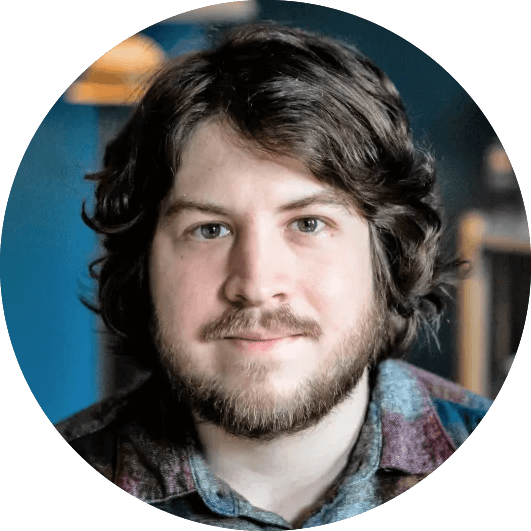Co-Supervising Sound Editor David Forshee digs into building the soundtrack of M. Night Shyamalan’s latest psychological horror film.
At first glance, you might think Knock at the Cabin is just another “cabin in the woods” slasher flick. But, as with all M. Night Shyamalan films, things are never what they seem. While almost all of the action takes place at a secluded cabin surrounded by lush forest, Co-Supervising Sound Editors David Forshee and Jill Purdy, along with re-recording mixers Grant Elder and Chris Cooke, worked hard to make the single location come alive and convey a range of emotions through creative application of sound.
The film begins by immersing the viewer in the perspective of Wen, a seven-year-old girl catching bugs in an idyllic forest while on vacation with her parents. But when four strangers show up wielding brutal makeshift weapons, things start to get interesting. Led by gentle giant Leonard (Dave Bautista), the four soon reveal the desperate situation they’re in—unbeknownst to the family, disasters of apocalyptic scale have begun killing off humanity and prophetic visions have led the strangers to the cabin, where they believe one of the three must be willingly sacrificed to save humanity. Much of the tension in the film comes from the cognitive dissonance between the serene environment of the remote cabin and the seemingly dire situation unfolding elsewhere. Likewise, the strangers’ threatening presence is juxtaposed by their calm demeanors and selfless dedication to saving the world.
In this interview, David Forshee (who also happens to be Pro Sound Effects’ Product Manager) shares thoughts on constructing immersive ambiences in Dolby Atmos, collaborating with the Foley team to convey a sense of danger, and his experience working with Shyamalan.
What were your initial thoughts in regards to the sound of this film, and what kind of direction were you given?
David Forshee: Any time there's a film that takes place in one quiet and intimate location, I try to wrap my head around the challenge of how to create a visceral experience when there’s a somewhat limited palette of sounds to work with. The first time I watch a film, I’m focusing on the story and which elements of the sound can support it thematically or otherwise. Immediately, I started thinking about the challenge of being in these locations for so long and everything being so exposed and how to keep it interesting.
When we did a spotting session with Night, a lot of the things he had to say were about really feeling the woods and the insects. The way he described the opening was that it should feel like waves of wind and insects. And ultimately, that led to a lush, meditative kind of fairytale feeling.
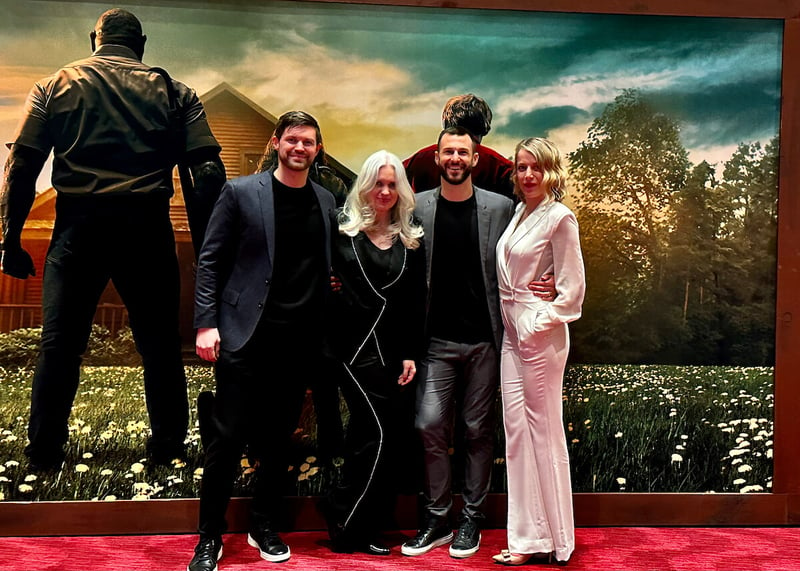
Left to right: David Forshee (Supervising Sound Editor), Jill Purdy (Supervising Sound Editor), Grant Elder (Re-recording Mixer), Noemi Preiswerk (Picture Editor)
The ambience of the woods really anchors the whole film. It feels very alive and enveloping, especially in Atmos.
That was the goal! We played a lot with cicadas, especially for the opening, because we wanted it to feel meditative and the cicada swells have a natural wave-like rhythm. We also tried to sell movement and perspective within the forest using more specific single insect elements, winds, and tree creaks.
We brought on Colin Hart, who is actually a Pro Sound Effects library partner – he did the Gators library – to do some field recording. Early on in the process, we sent Colin out to the actual location where they filmed the exteriors. He got some really good Ambisonic recordings, including a bunch of great winds all around the cabin and even some interiors in the treehouse. It was great to get the actual location. He also captured some very detailed recordings of grasshoppers with a Sanken CO-100k that we used throughout the film.
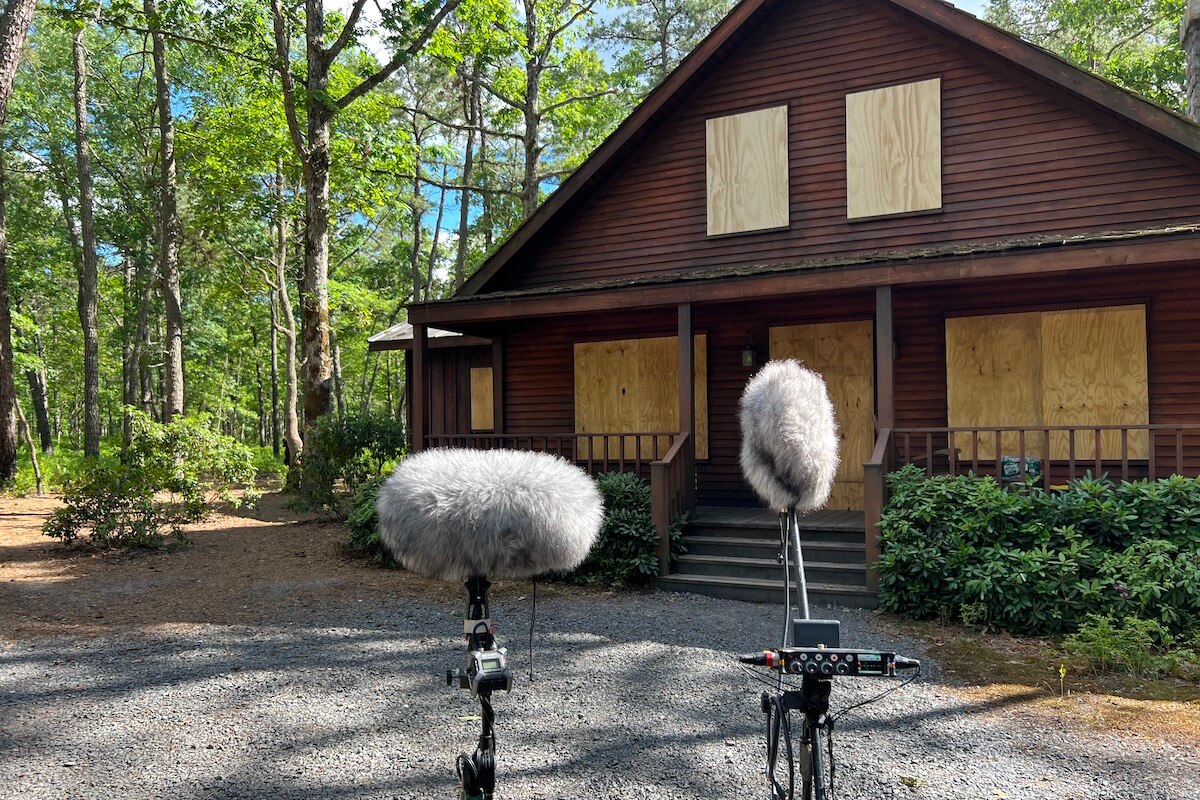
Recording ambiences on location
Can you break down the layers you used to construct that ambience?
The major categories were airs, winds, and insects. Then we embellished with lots of tiny specifics like tree creaks, winged insect bys, and squirrel barks that really brought it to life. There were a lot of layers, but it was all in service of creating the “right” composite sound. You have to be able to pull yourself outside of Pro Tools for a minute and just listen and ask yourself, “Is it the right sound?” There are many times where just one sound does the trick if you find the right one, but sometimes it takes a lot of ingredients or layers to construct the “right sound.” There are technical considerations too, and specifically for this one being mixed in Atmos, we had to cut enough material and orchestrate it to be Atmos friendly. I needed to give our brilliant FX and Foley mixer, Grant Elder, enough material to work with so he could pan things around the room and really bring the forest to life.
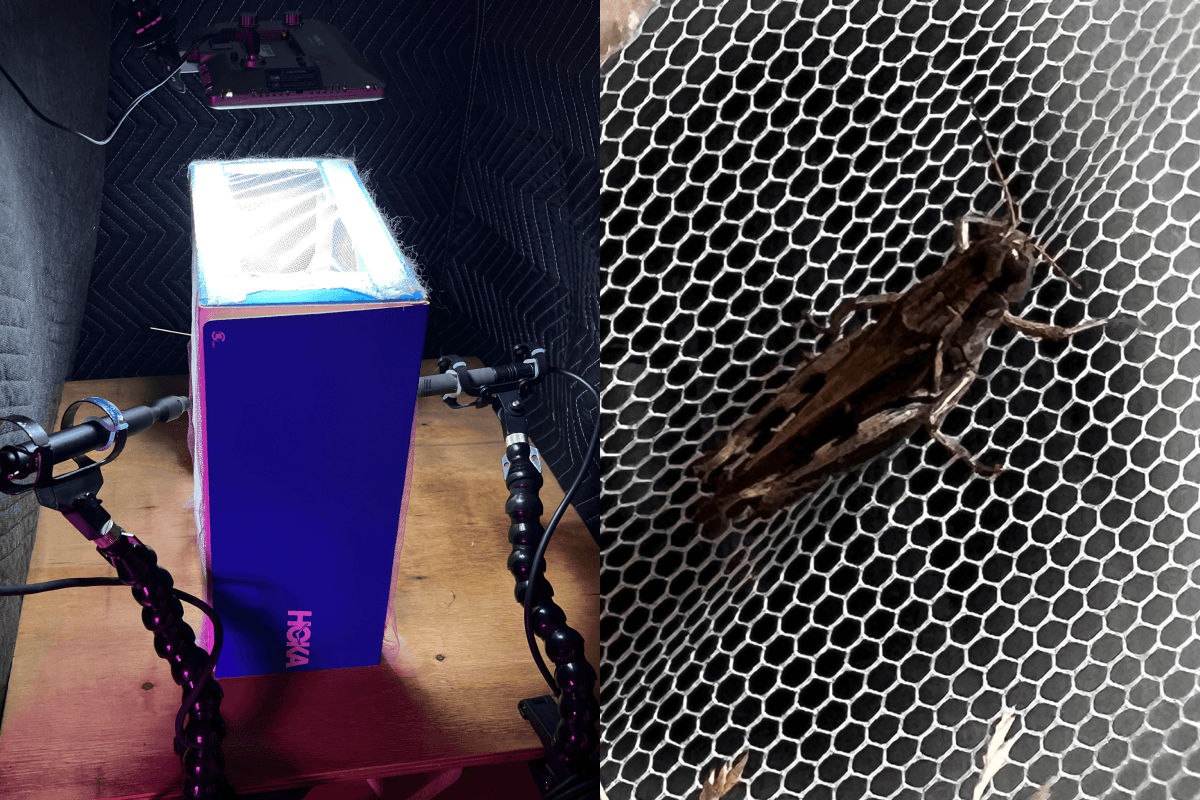
Recording insects
What kinds of sound effects libraries did you use?
Of course, I rely on Pro Sound Effects libraries. Sounds from Odyssey showed up here for sure, and definitely some of Richard King’s sounds. Those really stick to the screen because they were recorded with film in mind, so it makes sense that people gravitate toward those sounds. I also bought a handful of specialty libraries to fill gaps in my own library and for things that we didn’t have the time to go out and record ourselves.
The soundscape of the woods seems to change moods as the film progresses, starting out peaceful and serene before turning unsettling and even threatening. How did you use sound to create those different feelings?
Sometimes there was a time jump, so we relied on using different-sounding cicadas or katydids, which are really active in the evening. There’s a chase sequence that’s in the evening, so that was a really good excuse to bring out a whole new set of insects. We also put in a lot of twig snaps and other little sounds here and there to make you think, “Is this a threat?” As humans, that kind of reaction is baked into our DNA, so hearing these kinds of sounds in a forest always makes you perk up.
"You have to be able to pull yourself outside of Pro Tools for a minute and just listen and ask yourself, 'Is it the right sound?'"
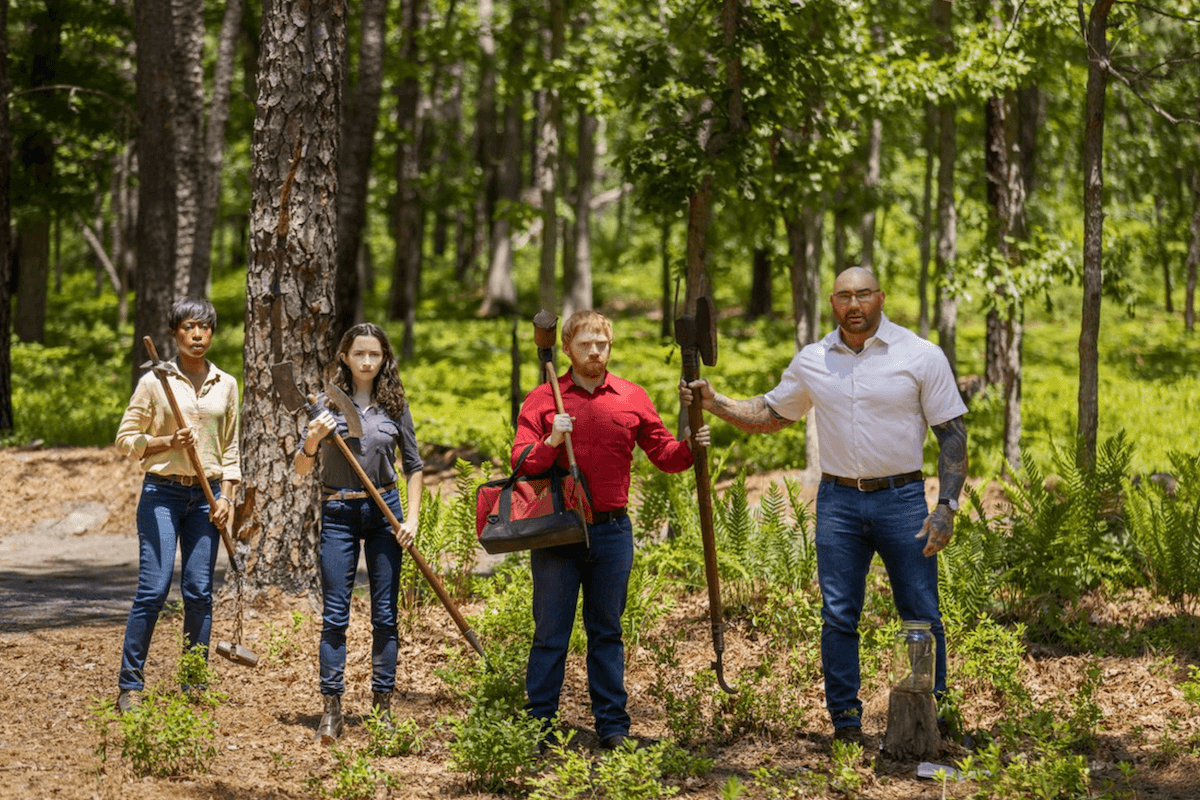
Photo: Aaron Ricketts/Universal Pictures
The four strangers are not portrayed as particularly scary and threatening as you might expect, but there are times when they are forced to use violence. Was it a challenge to make those scenes sound scary when the acting was so contrary to their actions?
A good example of this is the footsteps, which were mostly Foley, but they were embellished with recordings of creaky floors and things like that. We didn't really need to hold back too much to make them sound less threatening – in fact, we really leaned into it when we could. It was important anytime Leonard was walking around the cabin that we really felt this 300-pound man walking. The Foley team at Alchemy really delivered on making his footsteps feel that much bigger than the other characters and keeping that threatening presence there, even though he was the most soft-spoken gentle giant you can imagine.
With a lot of the impacts you hear in the action sequences, you're building them layer by layer. A lot of the time, I’ll start with the most literal thing – just the most logical idea for what something should sound like – and then intuit what else it needs – or if I need to go in a totally different direction. It may need to feel heavier, so I'll reach for some of the more “designy” impacts and layers to really beef it up. Or it might end up being too big for the moment and takes away from what Night is trying to accomplish with the shot, so we’d scale it down.
"Sounds from Odyssey showed up here for sure, and definitely some of Richard King’s sounds. Those really stick to the screen because they were recorded with film in mind, so it makes sense that people gravitate toward those sounds."
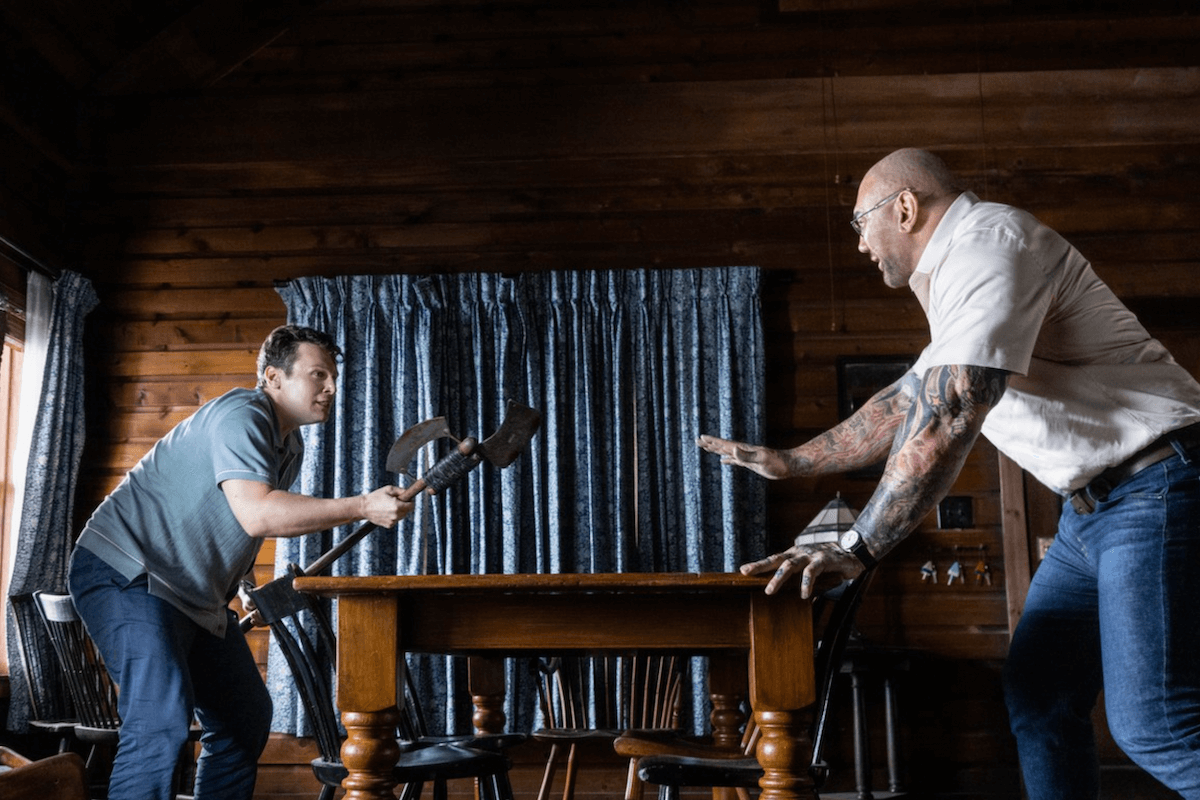
Photo: Aaron Ricketts/Universal Pictures
What insights did M. Night Shyamalan bring to the process, and how did it shape your approach to sound?
It was a very iterative process. The way Night likes to work, which I ended up loving, was to get everybody under one roof – including the picture editor and their assistants as well as the whole sound team – and just figure out how to make the best film we can.
Night has a very keen ear. He was a huge part of our process, and he pushed us to be bold with Atmos and to really feel the environments. Night was interested in exploring and pushing the boundaries by playing with the sound perspective and panning things around in Atmos. He also loved emphasizing cuts with shifts in the backgrounds which was very effective in communicating the blocking of the scene and the headspace of the characters.
The film takes place during what seems like the apocalypse, with megatsunamis hitting crowded beaches and airplanes falling out of the sky, but the characters mainly experience these events by watching the news on TV. Did you find that you had to scale down the sound design at all?
We had to find a balance because in the cabin, it's all coming through TV speakers, but when the camera zooms in, we wanted it to feel like we're on that beach. It wouldn't be quite as effective if we were purely playing it as if it were coming through TV speakers, so we had to figure out how to make the viewer feel the shock of seeing this on the TV.
For the airplane crashes, we leaned into just making it sound as realistic as possible and feeling that very distant, muffled explosion and the reverberation across a great distance. It feels creepy, and I think that's what we liked about it. It was more muffled, so you're not hearing the details; it's just this massive event and they're happening all over the place. All of these airplanes are falling out of the sky and all these people are dead in an instant, but all you hear at that distance is a muffled explosion. That felt like the most terrifying approach.
"[M. Night Shyamalan] has a very keen ear. He was a huge part of our process, and he pushed us to be bold with Atmos and to really feel the environments."
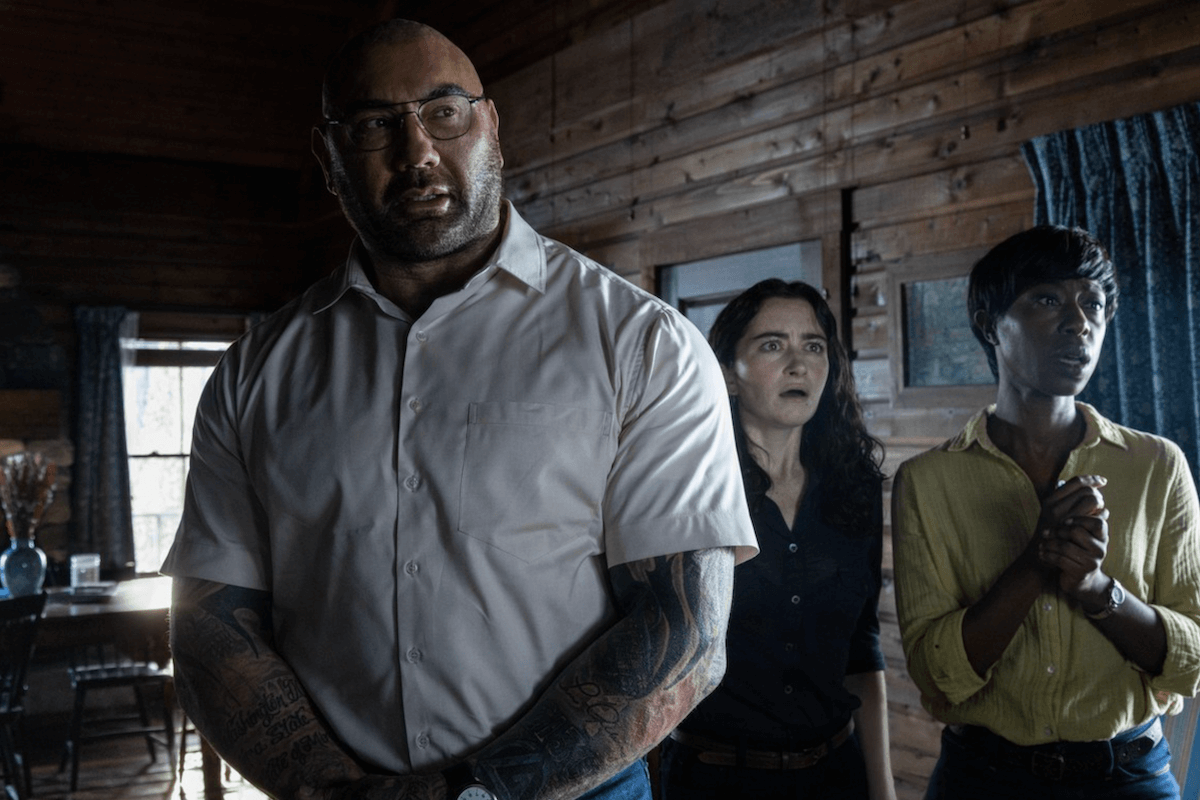
Photo: Aaron Ricketts/Universal Pictures
Without spoiling anything, there’s a scene toward the end of the movie with a lot of thunder, rain, and fire going on all at once, not to mention the score. Can you break down that scene and how you managed to incorporate all of those elements without creating a wall of noise?
That was tricky. There's a lot happening there, but Atmos is very helpful in being able to spread those sounds around. If they were all playing through one speaker, they would all kind of blend together into a mess of white noise, so it was nice to be able to have the sound of the rain hitting the leaves panned above you and the fire more localized. After that scene, we cut to the next shot and it's just rain and it’s such a nice contrast.
Overall, what was the trickiest part of the soundtrack to get right?
Finding the right sound for the footsteps and creaks of the four strangers on the porch when they first arrive. Night wanted you to feel their presence, hear them shifting around, and feel their movement on the porch as the camera pans. We had to make sure those creaks and the weapon movement and all of that felt just right, all while being filtered through the wall of the cabin. Balancing all of that was a very delicate process, and it took a few passes.
On a different note, there’s a moment where one of the characters recites exactly what the news anchor is saying live, and I was amazed at how clearly I could understand every word. That’s no easy feat, especially when today’s audiences increasingly expect ultra-clear dialogue.
That’s all thanks to Jill Purdy, my co-supervisor, and to Chris Cooke, our dialogue and music mixer. Jill supervised the dialogue and ADR and she is a magician. She did a ton of work cleaning up the dialogue and getting rid of the birds and creaks and camera noise that were in the production tracks. The result of all of that meticulous work is a crystal clear dialogue track that sounds buttery smooth and effortless. I was amazed at what they were able to pull off.
Sound Credits:
Supervising Sound Editors - Jill Purdy, David Forshee
Re-recording Mixers - Chris Cooke, Grant Elder
Assistant Sound Editor - Ja-Ann Wang
Sound Effects Editor - Natalia Saavedra Brychcy
Sound Effects Recordist - Colin Hart
Additional Sound Editor - Rachel Wardell
Mix Tech - Zack Booth
Foley Editor - Nick Seaman
Foley Artists - Leslie Bloome, Shaun Brennan, Curtis Henderson
Foley Mixers - Ryan Collison, Connor Nagy
Mix Facility - Soundtrack New York
ADR Mixers - Bill Higley (Soundtrack), Andrew Rice (Todd AO), Hunter Berk (Soundtrack), Simon Diggins (Goldcrest), Nick Roberts (De Lane Lea), Andre Kelman (Soundtrack), Michal Fojcik (Sound Mind)


